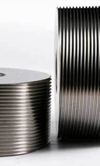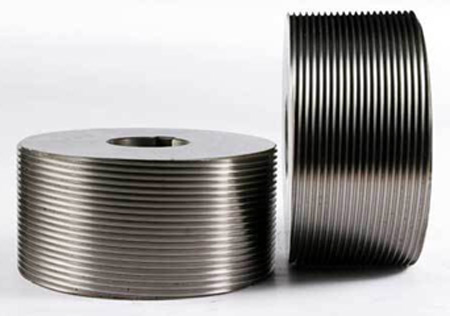Rolling threads
 When we look at a bespoke fastener for a race engine, it is often clear that a great deal of thought has gone into its design, and considerable effort into its manufacture. Fasteners for use in race engines typically see much higher stresses than a typical production engine fastener, and they also tend to accumulate stress cycles at a much faster rate than in most other applications. We should not therefore be surprised that a lot of attention is paid to fastener design, especially with fatigue in mind.
When we look at a bespoke fastener for a race engine, it is often clear that a great deal of thought has gone into its design, and considerable effort into its manufacture. Fasteners for use in race engines typically see much higher stresses than a typical production engine fastener, and they also tend to accumulate stress cycles at a much faster rate than in most other applications. We should not therefore be surprised that a lot of attention is paid to fastener design, especially with fatigue in mind.
Materials specially selected and processed to have high fatigue strengths are combined with design features that minimise stress concentration. Particular attention is paid to the underhead region of headed fasteners, and any transition from one diameter to another is generally achieved with a large radius. Also, very long fasteners may have supporting features along the shank to mitigate the effects of vibration.
One technique you will very rarely find used with any success on a highly stressed fastener is a machine-cut thread. While such machined threads are fine in some static applications, they are generally shunned where high cyclic stresses are found. Thread rolling is the preferred technique to produce fatigue-resistant male threads.
The process of thread rolling is carried out on a portion of plain-diameter bar that is carefully chosen to produce the correct result after having been rolled. The pre-rolling diameter is chosen according not only to the thread being formed, but also the material being rolled. Rolling is a cold-work process during which the workpiece is plastically deformed to produce an accurate thread.
While there should be very little geometric difference between a machined and a rolled thread, the difference in performance comes from the fact that the rolled threads have been produced by cold-working; the result of this is to leave the thread surfaces, including the highly stressed thread root, in a state of residual compression. This residual compressive stress serves to reduce the stresses induced by the working load on the bolt, producing the same effect as having a lower applied stress in a machined thread. We can therefore see that the effect of introducing the residual compressive stress due to rolling is to increase the fatigue strength of the fastener.

While we now have a better understanding of the effect of thread rolling and methods of predicting and quantifying the residual stresses thus produced, this has not always been the case. In their book of the early 1950s, Lipson et al* ascribe stress concentration factors to screw threads, and these are different for machine-cut and rolled threads, with a significantly higher factor being used for machine-cut threads.
Thread rolling is a specialist process; while it offers some very obvious benefits, it can also be done badly if you don't choose the right supplier. If you are designing and buying bespoke fasteners for the first time, you should take care to select a manufacturer with a good reputation and who can offer you advice on the design of your fastener to suit the rolling process.
*Lipson, C., Noll, G.C., and Clock, L.S., "Strength of Manufactured Parts", McGraw Hill, 1950
Fig. 1 - These are typical thread rolls used for producing high-quality male threads
Written by Wayne Ward